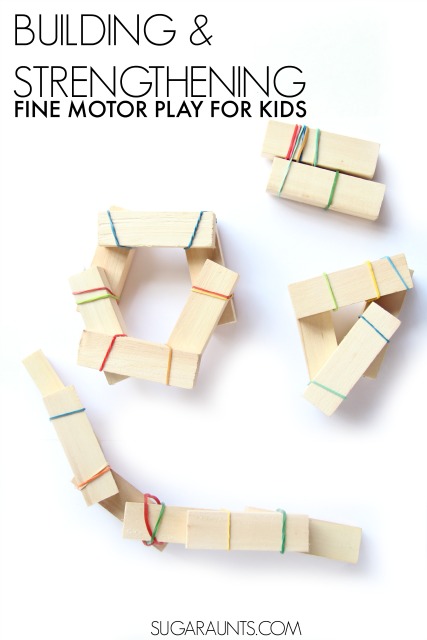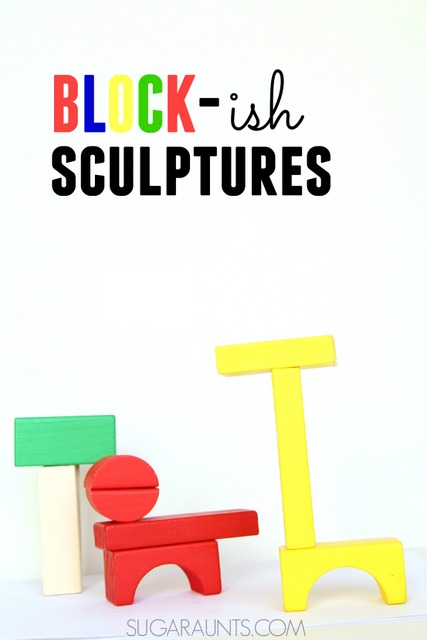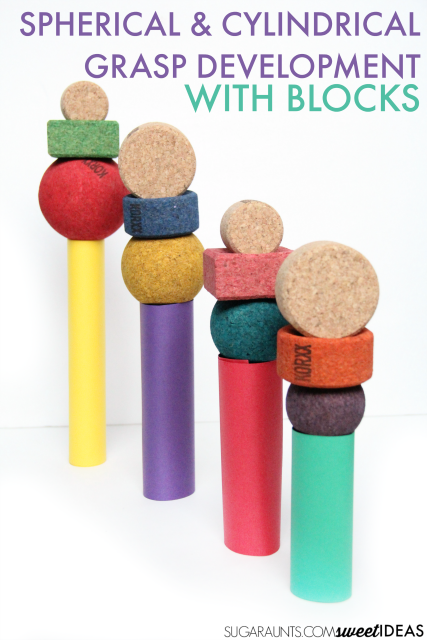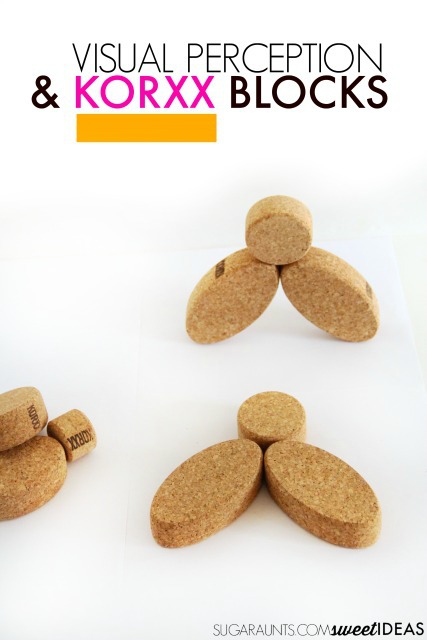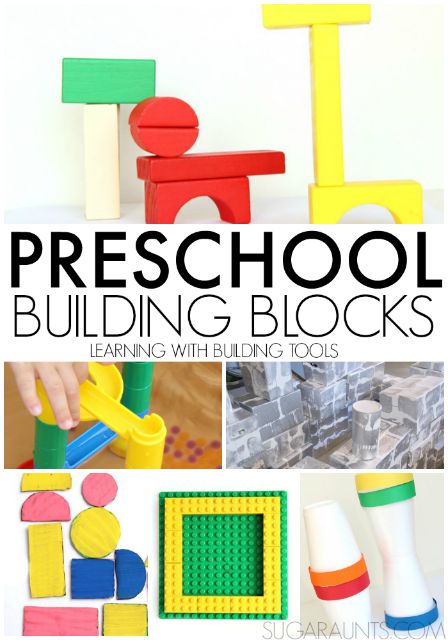As a pediatric occupational therapist, I’ve used wooden building blocks in occupational therapy many times. For my own children, I’ve used regular wooden blocks as a fine motor tool too! In fact, building with blocks is a fine motor skills that kids need in order to fine motor development many, many, (MANY) times. Wooden blocks are a tool that are used for development of goal progression in treatment activities and in assessment of fine motor developmental level. They are used in visual perceptual skills, and are the perfect open-ended play item.
Also be sure to check out our activity using cardboard bricks as a tool for developing many areas.
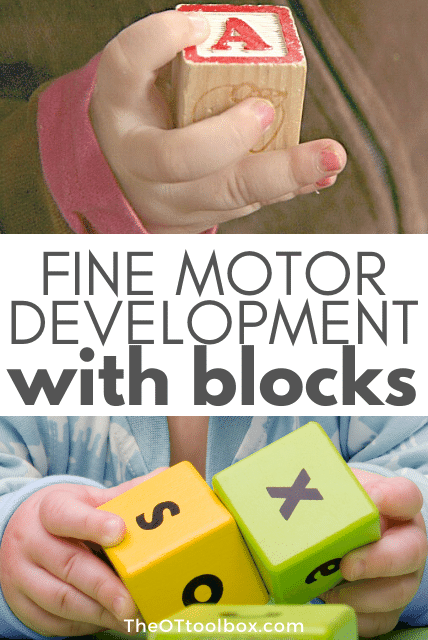
Many parents ask “is stacking blocks a fine motor skill?” The answer is YES!
As a Mom and OT, I’ve made sure my kids have a lot of wooden blocks (and a couple of varieties of toddler large blocks of the foam and plastic blocks, too!)
Today, I’m sharing how to use wooden blocks in fine motor skill development with kids…all while they play and don’t even realize their fine motor skills are being assessed or worked on! This is a great way to address skills for children and adults…anyone who needs to work on fine motor skill development.
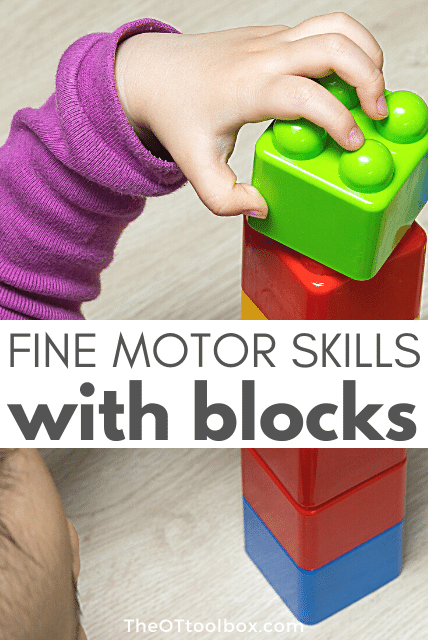
Fine Motor Skills and Building Blocks
Full disclosure: This post contains affiliate links.
Stacking blocks is a fine motor skill. And, when children stack blocks, they develop and refine fine motor skills. Check out the list of benefits of playing with blocks that are described below. Each area of development can be developed using a set of building blocks.
Looking at various building blocks from the perspective of an occupational therapist, my favorite wooden blocks are Melissa and Doug Wood Blocks Set. The set is huge and comes with a variety of bright colors in solid wooden blocks, which are sized just right to help kids build fine motor skills.
Fine motor skills and building blocks go hand-in-hand…literally! There are SO many benefits to playing with blocks. Let’s break down all of the benefits of playing with blocks…
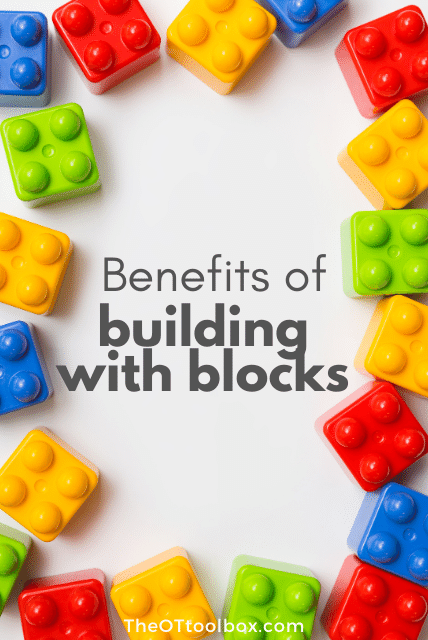
Benefits of Playing with Blocks
- Building with blocks help kids develop grasp- From the time toddlers can grasp a block with their whole hand, grasp development begins. Blocks are a fine motor power tool when it comes to working on grasp development! Read below for the specifics of small kids playing with blocks. By picking up on block, manipulating it in the hand, and placing it on a stack of blocks, children progress from a gross grasp to a radial palmer grasp and then to a digital palmer grasp, followed by a tip-to-tip grasp using the pointer finger and thumb.
Check out this developmental checklist for more information.
2. Building with blocks helps kids develop graded fine motor skills- As small children progress through typical grasp progression, they begin to gain more control over those motor skills. This occurs on a stability basis (use of the core and shoulder to stabilize the arm) and on a dexterous basis (precise, small, and graded movements of the fingers). By gaining these skills, children are able to pick on one block from a stack without toppling the entire block tower. They are also able to place a block onto a stack of blocks without knocking over the entire tower. These graded movements are essential for precision and dexterity in functional tasks as children gain a sense of personal awareness and how their body moves through space in order to pick up and manipulate objects.
This blog post on fine motor precision and graded release explains more on this skill and has a fun fine motor activity to develop graded precision in fine motor skills.
3. Building with blocks helps children develop eye-hand coordination- From a very young age, when babies develop the ability to see and move their arm to reach for a block, those eye-hand coordination skills are beginning to develop. Visual motor integration is a main piece of the visual processing skills puzzle, and coordinating movements with visual information is essential for so many functional tasks in learning and play. Catching a ball, writing with a pencil, cutting with scissors, are just a few examples of eye-hand coordination tasks that rely on the baseline skills developed from a young age. Toddlers can manipulate and build with blocks while developing this skill through play. Stacking, knocking blocks over, building a block train, making towers, and using blocks in constructive play are powerful tools to developing eye-hand coordination skills.
Like blocks, there are many toys to promote eye-hand coordination.
4. Building with blocks helps children develop bilateral coordination– Establishing a hand dominance and laterality is an important fine motor skill that transfers to tasks like writing with a pencil and holding the paper with the nondominant hand. Another example is mastering a zipper while stabilizing the material with the other hand. Still another example of bilateral coordination is cutting with scissors while holding and manipulating the paper with the nondominant hand. All of these tasks requires one hand to manipulate objects with more precision and dexterity while the other acts as a stabilizer. Building with blocks builds bilateral coordination as children stabilize a stack of blocks with one hand and use the other hand to release a block at the top of the stack with graded precision.
Here are more bilateral coordination activities that develop this essential motor skill.
5. Building with blocks helps children develop motor planning skills– Motor planning is a physical action that requires observing and understanding the task (ideation), planning out an action in response to the task (organization), and the act of carrying out the task (execution). Building with blocks is a great way to build these sub-skills as kids attempt to build with blocks to construct with blocks.
Here is more information on motor planning in kids.
6. Building with blocks helps children integrate the proprioceptive sense– Proprioception is one of our sensory systems that focuses on awareness of how one’s body moves through space, and how much effort is needed to move in certain ways. The proprioception system receives input from the muscles and joints about body position, weight, pressure, stretch, movement and changes in position in space. Our bodies are able to grade and coordinate movements based on the way muscles move, stretch, and contract. Proprioception allows us to apply more or less pressure and force in a task. Instinctively, we know that lifting a feather requires very little pressure and effort, while moving a large backpack requires more work. We are able to coordinate our movements effectively to manage our day’s activities with the proprioceptive system. The brain also must coordinate input about gravity, movement, and balance involving the vestibular system. Building with blocks is a great way to develop and refine this skill. How much effort is needed to pick up a block and place it in a specific spot without moving other blocks while building a tower of blocks or a block building?
To take this a step further, use larger blocks that require gross motor skills, and more awareness of proprioception skills. Here are DIY cardboard blocks that we’ve made for this very purpose.
Here is more information on proprioception activities.
7. Blocks help children integrate midline awareness– Crossing midline can be developed from a young age when playing with blocks. This is a great way for babies and toddlers to work on crossing midline, by reaching for blocks, building, and creating.
Here is more information on crossing midline.
8. Blocks help children develop visual motor skills- Visual motor skills (and visual motor integration) are needed for coordinating the hands, legs, and the rest of the body’s movements with what the eyes perceive. Visual motor skills are essential to coordinated and efficient use of the hands and eyes. Visual motor integration is a skill we require for functioning. There is more that plays into the integration of visual motor skills into what we do and how we use our hands in activities. Building with blocks helps children develop skills in visual perception, eye-hand coordination, and visual processing skills play a part in the overarching visual motor skill development so we can perceive and process visual information and use that information with motor skills to manipulate and move objects in tasks and activities.
By building with blocks, areas like form constancy, visual attention, visual discrimination, spatial relations, visual memory, visual sequential memory, and visual figure ground are developed in accordance with eye-hand coordination, and visual efficiency.
Here is more information on visual motor skills.
9. Building with blocks develops learning too! Beyond fine motor skills, building with blocks helps kids develop other skills too. What will your toddler learn by picking up Wood Blocks Set, placing them into a container, and stacking towers? (Among other skills):
- Cause and effect
- Problem solving
- Spatial awareness
- Copying a design or visual prompt
- Problem solving
- Math: patterns, sizing, spatial concepts
- Literacy
- Manipulation
- Depth Perception
Here are more ways to use blocks to build skills in babies and toddlers.
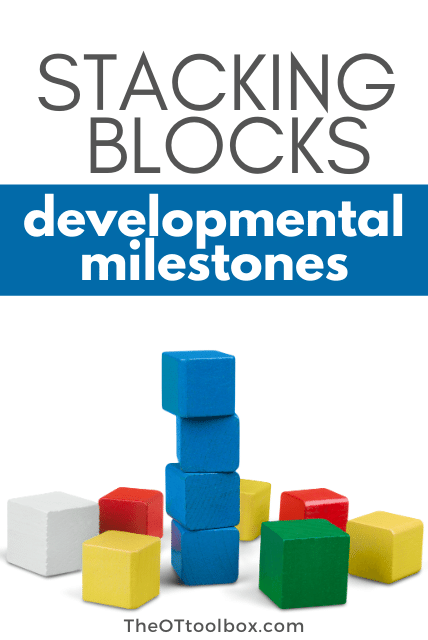
Building Blocks and Development
From developing a palmer grasp transition to a radial grasp to a tripod grasp and precision with graded release of motor skills, building with blocks help kids develop so many skills. For today’s activity, we pulled out the one inch square blocks from the set and we used classic Alphabet blocks. (This set has been chewed on and played with by all four of my kids so they look well loved aka have chew marks!)
First up in developing fine motor skills with wooden blocks is the grasp. This is important in fine motor skills in toddlers. Blocks, for toddlers are a fine motor tool that builds on so many areas.
Stacking Blocks developmental milestones
The developmental ages of this progression are as follows:
Grasps a block with whole fist, lifting it off a table surface without dropping: 5 months
Grasps a block with all fingers: 6 months
Drops one block when given another: 6 months
Brings hands together when holding a block: 6 months
Grasps a block between the thumb, pointer finger, and middle finger (radial-palmer grasp): 7 months
Transfers a block from one hand to the other: 7 months
Bangs to wooden blocks together with both hands: 9 months
Grasps a block between the thumb, and the pads of the pointer and middle fingers with space between the block and the palm (radial-digital grasp): 11 months
Places wooden blocks into a container: 11 months
Builds a tower of three wooden blocks given a visual example: 15-16 months
Copies and builds a tower of 5 blocks: 19-20 months
Copies and builds a tower of 6 blocks: 21-22 months
Builds a tower of 8 blocks: 25-26 months
Copies a four block “train”: 29-30 months
Builds a 10 block tower: 29-30 months
Copies a three block pyramid or “bridge”: 31-32 months
Copies a four block “wall”: 35-36 months
Builds “steps” using six blocks: 51-52 months
Builds a six block pyramid: 53-54 months
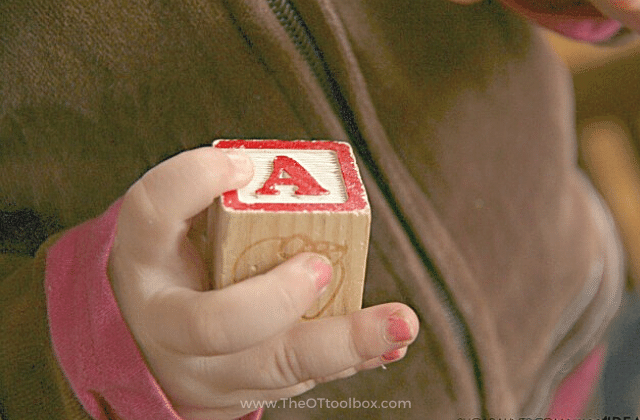
This Radial Palmer Grasp of wooden block is a beginning grasp in toddlers.
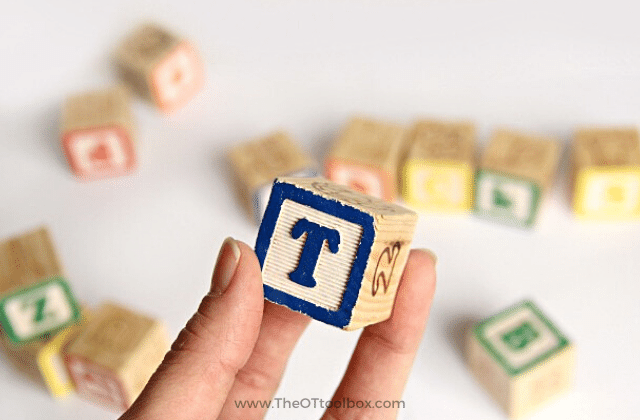
After a radial palmer grasp, children progress to using a Digital Palmer Grasp of a Wooden Block. When children progress in development is the digital palmer grasp of holding a block, fine motor skill development speeds up fast. By holding a block with the pads of the thumb and pointer and middle fingers, kids are working on the in-hand manipulation skills they will need for manipulating a pencil. Make it fun while working on this area: Spin the block around with the tips of the fingers.
How does rotation in the hand help with functional skills? You need simple and complex rotation to complete these tasks:
- Rotating a pencil when re-positioning while writing
- Opening a toothpaste lid
- Turning a paper clip
- Turning knobs
- Rotating the dial of a combination lock
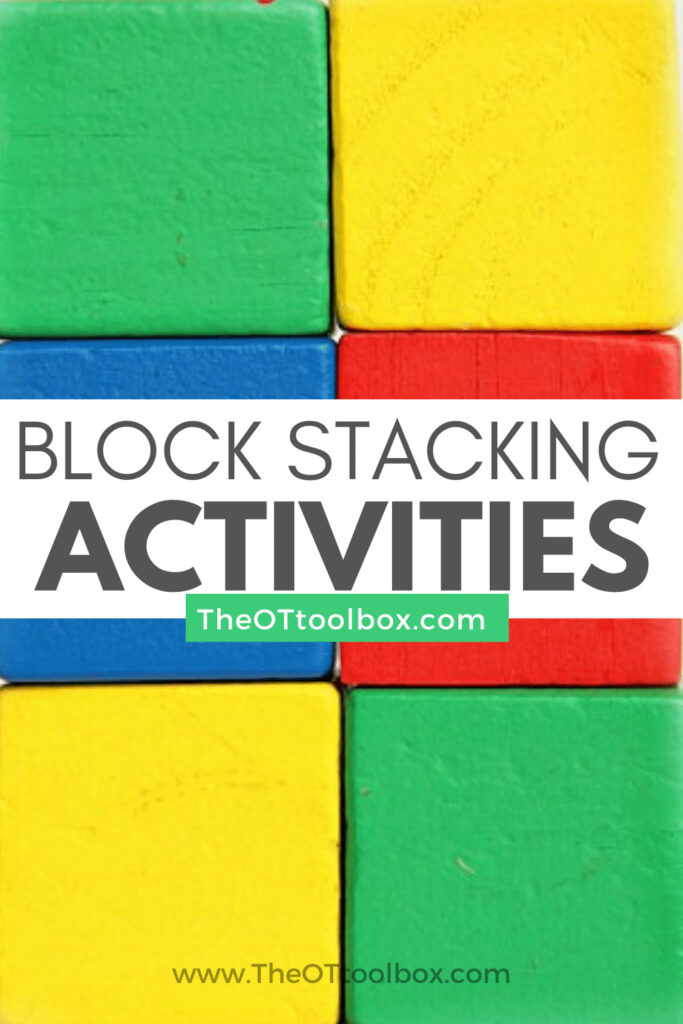
Block Stacking Games
Now that you’ve read through the benefits of playing with blocks, and the stacking block milestones that impact fine motor skills in children, let’s cover ways to play with blocks while building these essential skills.
While stacking blocks and knocking them down are a fantastic way to help small children build essential skills, there are so many more ways to play with blocks, too.
These block stacking games and block activities can be used for fun block ideas while building skills at home or in occupational therapy sessions.
- With my toddler, we used the blocks to build small towers. So, how can you make this a fun activity? Usually, just playing with your kiddo and showing them how to build a tower and knock down a tower makes building with blocks fun at this age.
- These Alphabet blocks are great for working on rotation of the fingers. Have your child look for specific shapes and letters on the sides of the blocks.
3. Add small toys like animal figures. Have the animals walk up and down the block steps.
4. Add play dough. Have the child create “mortar” using the play dough between each block.
5. Create a train track and push coins around a masking tape track.
6. Build a wall to divide animal figures into a miniature zoo.
7. Build a small bridge for small doll or animal figures.
8. Build a pyramid and place a coin on each level.
9. Sort the blocks into piles according to shape or color. Create patterns with colors or shapes. Make lines of the blocks and see which line has the most.
10. Build blocks in water. Use foam blocks or plastic blocks in a low tray of water. How does the water impact stacking? Can you add soap foam? What happens then? There is so much cause-and-effect happening with water and block play! Here you can see how we used water and foam blocks for fine motor skills.
Let your child use their imagination! The best thing about blocks are the open ended-ness that happens when playing. You can create houses, roads, animals, and any imaginative scene possible with just a set of blocks!

Copying Block Designs in Occupational Therapy
Beyond the fine motor skills listed above, there are visual motor skills that develop as well. This was covered briefly above, but to expand, copying block designs in occupational therapy is a skill that builds visual motor and visual perceptual skills needed for handwriting, reading, math, finding items like a utensil in a drawer, and so much more.
When children copy block designs, occupational therapists are working on areas such as spatial awareness, visual discrimination, visual attention, visual sequential memory, visual memory, form constancy, position in space, and other areas.
From top right and going clock-wise: 3 block pyramid or bridge, wall, pyramid, steps, and train. Copying specific shapes works on the eye-hand coordination, grasp, precision, and visual perceptual skills needed for functional tasks like handwriting, cutting with scissors, manipulating small items, managing clothing fasteners, and tying shoes, among so many other tasks.
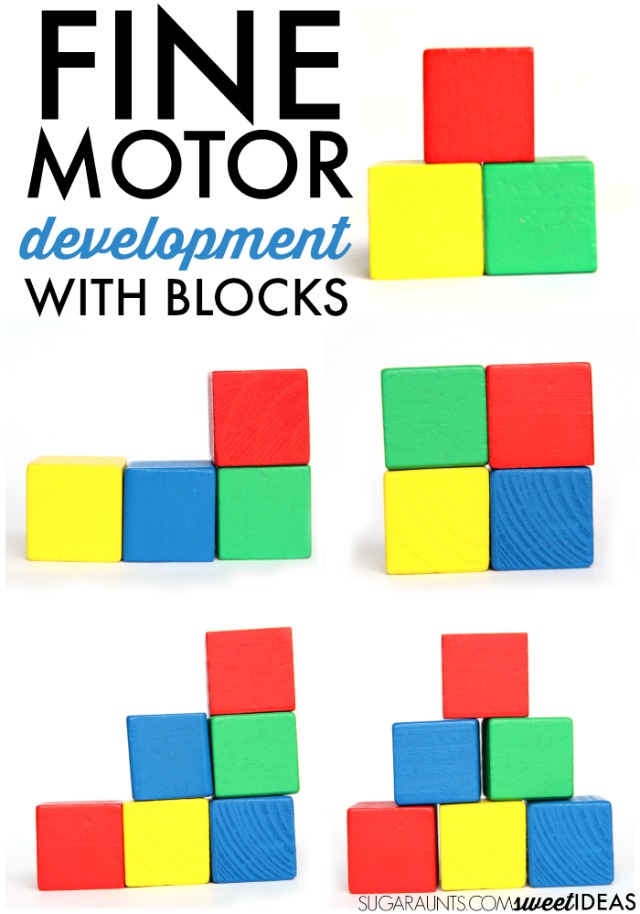
To make copying shapes with blocks fun, try these ideas:
- Build a block design alongside the child.
2. Build a block design using only one color of blocks.
3. Build a block design and then cover it with a small dishtowel. Can the child remember the design and build the same design?
4. Build a design and describe the blocks positions. Is one color on top or next to another? Use positioning words like next to, above, below, beside, to the left, to the right, etc.
5. Build bridge block designs and use small figures to cross the bridges.
6. Use different types of blocks. Try using LEGO, duplo blocks, rock blocks, or other three dimensional shapes. The part to focus on is coping forms in the three dimensional aspect, regarding position in space. There are so many different types of blocks on the market that work well for developing these skills.
7. Try building a small block form and then drawing it on paper.
8. Play “What’s Missing”. Build a block design and ask the child to look at the design for 20 seconds. Then, cover the design with a small dishtowel and remove one or more of the blocks. Can the child then look at the block design and figure out what is missing?
9. Make and build- Use colored paper to cut small squares that match the blocks you have in your set. Students can use the paper to “build” a two dimensional block design on paper or on the table top. Then, use real blocks to copy the paper design. This is an exercise in spatial concepts as students need to figure out any blocks that are out of view to hold up the block design.
10. Build block designs in a window or in a sunny place where the design creates a shadow. A flashlight or small lamp could also work as well. Then, place a piece of paper alongside the block design. Ask students to trace the shadow outline.
11. Create block forms that resemble real-life shapes, figures, and other relatable objects. Kids can copy block forms that resemble their favorite animals, people, and things like ice cream cones, presents, toys, vehicles, etc.
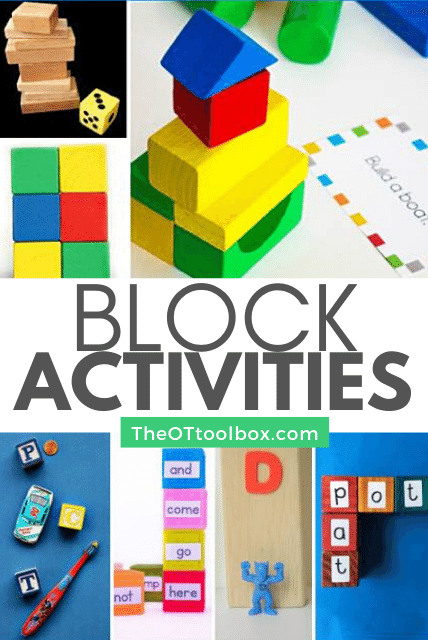
Looking for more block activities?
These Building Block STEM Challenge Cards challenge visual perceptual skills and visual motor skills. They also offer children a chance to build their problem solving skills and engineering skills with a STEM challenge.
Pair block building with a children’s book in this Ish Block Activity.
This Fractions with KORXX Block activity is a great hands-on math activity using blocks to challenge children who are learning fractions.
Use blocks and rubber bands to work on hand strength. Children can copy simple forms and connect them together using rubber bands.
A Building Block Maze Activity focuses on gross motor skills and builds spatial awareness skills as well as body awareness and self-awareness to position in space.
This Building Tens Castles is a nice way to help preschool and kindergarten aged students with the concept of tens and place value as they group blocks into groups of tens.
This Word Family BINGO! challenges kindergarten and first grade students to build words by using blocks. It’s a hands-on learning activity that also develops visual perceptual skills, and visual scanning.
A Building Block Addition Towers helps students with math concepts.
Letter matching with this Superhero Alphabet Matching Activity uses blocks to work on letter awareness, recognition, as well as visual perceptual skills.
This Sight Word ABCs with Blocks allows younger elementary school children to work on sight words as well as visual perceptual skills, eye-hand coordination, and motor planning.
For a gross motor activity that gets kids moving, use blocks to work on letters and sounds with this Letter Sound Scavenger Hunt.
Symmetrical awareness is a test of visual discrimination, form constancy, and visual memory. Work on symmetry with this Symmetry with Building Blocks activity.
This word building activity focuses on Building CVC words with Blocks and challenges children with visual perception and visual motor skills.
Working on visual attention, visual memory, and visual discrimination is easy with a block activity like this Making Patterns with Building Blocks idea.
Our favorite block ideas:
How do you like to play with blocks? Have you tried working on fine motor skills using wooden blocks? Let us know!

Colleen Beck, OTR/L has been an occupational therapist since 2000, working in school-based, hand therapy, outpatient peds, EI, and SNF. Colleen created The OT Toolbox to inspire therapists, teachers, and parents with easy and fun tools to help children thrive. Read her story about going from an OT making $3/hour (after paying for kids’ childcare) to a full-time OT resource creator for millions of readers. Want to collaborate? Send an email to contact@theottoolbox.com.


